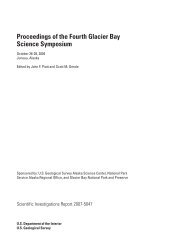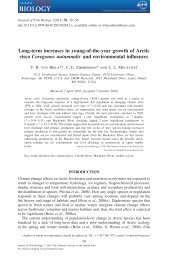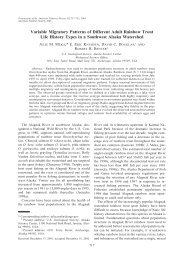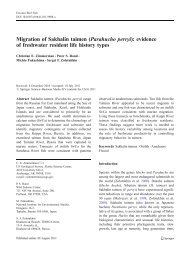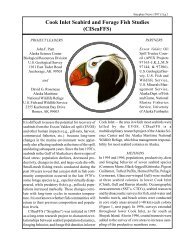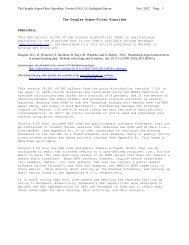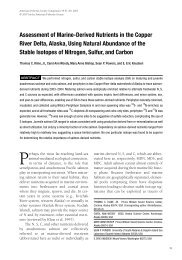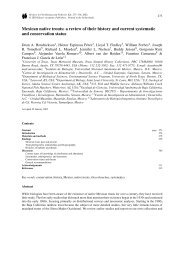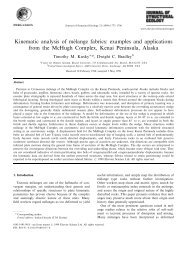Tectonic Controls of Mississippi Valley-Type Lead-Zinc ...
Tectonic Controls of Mississippi Valley-Type Lead-Zinc ...
Tectonic Controls of Mississippi Valley-Type Lead-Zinc ...
You also want an ePaper? Increase the reach of your titles
YUMPU automatically turns print PDFs into web optimized ePapers that Google loves.
12/2/02, 3:12 PM 1Dwight C. Bradley • David L. Leach<strong>Tectonic</strong> <strong>Controls</strong> <strong>of</strong> <strong>Mississippi</strong> <strong>Valley</strong>-<strong>Type</strong><strong>Lead</strong>-<strong>Zinc</strong> Mineralization in Orogenic ForelandsReceived: ## ####### #### / Accepted: ## ####### #### / Published online: ## ####### ####Abstract Most <strong>of</strong> the world’s <strong>Mississippi</strong> <strong>Valley</strong>-type (MVT) zinc-lead deposits occur inorogenic forelands. We examine tectonic aspects <strong>of</strong> foreland evolution as part <strong>of</strong> a broader study<strong>of</strong> why some forelands are rich in MVT deposits whereas others are barren. The type <strong>of</strong> orogenicforeland (collisional versus Andean-type versus inversion-type) is not a first-order control, becauseeach have MVT deposits (e.g. Northern Arkansas, Pine Point, and Cevennes, respectively). In someMVT districts (e.g. Tri-State and Central Tennessee), mineralization took place atop an orogenicforebulge, a low-amplitude (a few hundred m), long-wavelength (100-200 km) swell formed byvertical loading <strong>of</strong> the foreland plate. In the foreland <strong>of</strong> the active Banda Arc collision zone, adiscontinuous forebulge reveals some <strong>of</strong> the physiographic and geologic complexities <strong>of</strong> theforebulge environment, and the importance <strong>of</strong> sea level in determining whether or not a forebulgewill emerge and thus be subject to erosion. In addition to those on extant forebulges, some MVTdeposits occur immediately below unconformities that originated at a forebulge, only to besubsequently carried toward the orogen by the plate-tectonic conveyor (e.g. Daniel’s Harbour andEast Tennessee). Likewise, some deposits are located along syncollisional, flexure-induced normaland strike-slip faults in collisional forelands (e.g. Northern Arkansas, Daniel’s Harbour, and Tri-State districts). These findings reveal the importance <strong>of</strong> lithospheric flexure, and suggest aconceptual tectonic model that accounts for an important subset <strong>of</strong> MVT deposits—those in theforelands <strong>of</strong> collisional orogens. MVT deposits occur both in flat lying and in thrust-faulted strata;among the latter group, mineralization postdated thrusting in some instances (e.g. Picos de Europa),but may have predated thrusting in other cases (e.g. East Tennessee).Keywords <strong>Mississippi</strong>-<strong>Valley</strong>-type deposit • foreland basin • collisional orogeny • forebulge •flexural extensionIntroductionThe past quarter century has seen major advances in the understanding <strong>of</strong> the genesis <strong>of</strong><strong>Mississippi</strong> <strong>Valley</strong>-type (MVT) lead-zinc deposits (Fig. 1). Until the early 1980s, many workersbelieved that plate tectonics played no direct role and that MVT mineralization required little morethan the presence <strong>of</strong> platformal carbonates. Recent studies have shown instead that most (thoughnot all) MVT deposits were produced by enormous fluid systems that migrated through forelandbasins, driven by gravity from an adjacent orogenic belt (e.g. Garven 1985, Ge and Garven 1992,Appold and Garven 1999, Leach et al. 2001a). Why, then, are some forelands rich in MVT deposits,whereas other forelands are barren? One likely, though admittedly vague explanation, is thatforeland basins are not all alike. They form in a variety <strong>of</strong> convergent tectonic settings at allpaleolatitudes, they range from deep, narrow marine flysch troughs to wide, nonmarine clasticwedges, and they evolve through time. Because such factors should have major impacts onregional-scale hydrogeology, they might also be expected to play a role in the genesis, or not, <strong>of</strong>MVT deposits.Fig 1 about here.
12/2/02, 3:12 PM <strong>Tectonic</strong> <strong>Controls</strong> <strong>of</strong> MVT Mineralization 4degraded as to lose its hydrological integrity, and thus lose its potential to transmit the enormousvolumes <strong>of</strong> fluids required <strong>of</strong> MVT systems.Some MVT districts are clearly related to collisional orogenic forelands. The most straightforwardexample is provided by Ozark MVT deposits that include the Southeast Missouri (Viburnum Trendand Old <strong>Lead</strong> Belt), Northern Arkansas, Tri-State and Central Missouri districts, which lie in theOuachita foreland (Fig. 4). The Ouachita orogen is a fold-thrust belt that formed during the<strong>Mississippi</strong>an to Pennsylvanian collision between the passive margin <strong>of</strong> Laurentia and anaccretionary wedge in front <strong>of</strong> a north-facing arc. Collision followed subduction <strong>of</strong> an ocean <strong>of</strong>unknown width (e.g. Viehle 1979; Lillie et al. 1983; Houseknecht 1986). Breakup <strong>of</strong> Rodiniaduring the Late Precambrian led to the formation <strong>of</strong> the Ouachita passive margin by Cambrian time(Thomas 1991). The passive margin endured about 200 m.y. In thrust sheets in the OuachitaMountains, Cambrian to Lower <strong>Mississippi</strong>an slope and rise facies are overlain by Lower<strong>Mississippi</strong>an (late Meramecian, ~336-331 Ma) 1 flysch. The flysch is interpreted to record arrival<strong>of</strong> the distal continental margin at a trench. The frontal part <strong>of</strong> the orogen and adjacent flat-lyingrocks to the north define the Arkoma foreland basin, filled by as much as 8 km <strong>of</strong> flysch andmolasse. These strata were deposited during the Atokan (Early Pennsylvanian, ~314-311 Ma) andDesmoinesian (mid-Pennsylvanian, ~311-305 Ma) (Houseknecht 1986; Sutherland 1988). TheArkoma Basin laps to the north onto the Ozark dome, a tract <strong>of</strong> mainly Cambrian to Pennsylvaniancarbonate-dominated platform facies that host the MVT deposits. The older carbonates weredeposited first along the Laurentian passive margin, facing an open ocean, whereas the youngestcarbonates were deposited along the cratonic margin <strong>of</strong> the advancing foredeep. The MVT depositsin the Ozark region are located on the area <strong>of</strong> the forebulge, and some orebodies are located alongflexure-induced normal faults. The deposits formed after collision. These points are elaborated insubsequent sections. The single most important point illustrated by the Ozark MVT deposits is thatthey are related to a simple arc-passive margin collision; no subsequent orogenies complicatematters.Figure 4 near here.Andean-type orogens and their forelandsAndean orogens form above continental-margin subduction zones in which the upper plate is incompression, as manifested by crustal thickening along the arc and by development <strong>of</strong> a thrust beltand foreland basin in the backarc (Fig. 2B) (Dewey 1980). Although some early plate-tectonicmodels suggested otherwise, Andean-type arcs appear not to form directly by initiation <strong>of</strong>subduction along passive margin, but instead by one or more collisions, the first involving a passivemargin and an arc, followed by subduction flip (Burke et al. 1984).MVT deposits <strong>of</strong> the Canadian Rockies and its foreland show a clear relationship to Andean-typeorogeny. Late Proterozoic rifting followed by thermal subsidence during the early Paleozoic (Bondand Kominz 1984) produced a westward-thickening carbonate platform flanked to the west bydeep-water facies. Cambrian to Late Devonian passive-margin carbonates host the MVT deposits.Near the end <strong>of</strong> the Devonian, an influx <strong>of</strong> flysch from outboard sources most likely recordscollision <strong>of</strong> a Devonian arc (Smith et al. 1993). This orogenic clastic sequence never prograded veryfar to the east; on the miogeocline, mixed carbonate and clastic platform deposition lasted into mid-Jurassic. From then until the Paleocene, an Andean-type thrust belt (Canadian Rockies) and its1 Carboniferous time scale based on Europe-North America correlations summarized in Harland et al. (1990),calibrated to the numerical time scale <strong>of</strong> Menning et al. (2000).
12/2/02, 3:12 PM <strong>Tectonic</strong> <strong>Controls</strong> <strong>of</strong> MVT Mineralization 5foreland basin (Western Interior basin) advanced cratonward (McMechan and Thompson 1993).The MVT deposits <strong>of</strong> western Canada occur in both the undeformed foreland (Pine Point) and inthe thrust belt (Robb Lake and Monarch-Kicking Horse). The flat-lying rocks <strong>of</strong> the Pine Pointdistrict are located near the cratonward edge <strong>of</strong> the Western Interior foreland basin. The oredeposits are hosted in paleokarst in a Middle Devonian carbonate barrier complex. Rb/Sr dating <strong>of</strong>sphalerite has yielded isochron ages <strong>of</strong> 361 ± 13 Ma and 374 ± 21 (Nakai et al. 1993; J. Brannonpersonal communication in Symons et al. 1998a). These results are not much younger than the hostrock, and may date Devonian clays entrapped in much younger sphalerite (Symons et al. 1998).Paleomagnetic dating at Pine Point indicates a more plausible latest Cretaceous to Paleocene age(71 ± 13 Ma) (Symons et al. 1993), implying mineralization in a distal Andean-type foreland. Aswill be discussed later, the MVT deposits in the thrust belt also have yielded Late Cretaceous andEocene paleomagnetic ages (Symons et al. 1998a; Smethurst et al. 1999), in support <strong>of</strong> the youngerage for Pine Point.Inversion-type orogens and their forelandsOrogens formed by inversion <strong>of</strong> sedimentary basins (Fig. 2C) comprise a third category known tobe associated with MVT deposits. These orogens do not form upon closure <strong>of</strong> an ocean basin bysubduction, but within continental crust. To call such orogens “collisions” is a misnomer, becausethe two converging objects are already juxtaposed from the start. The example most pertinent toMVT deposits is the Pyreneean Orogen <strong>of</strong> southern Europe. During the opening <strong>of</strong> the NorthAtlantic, as the Americas moved away from Europe and Africa, Iberia moved as an independentblock. From Permian to Late Cretaceous, a series <strong>of</strong> rift basins subsided between Europe and Iberia(e.g. Puigdefabregas and Souquet 1986). From late Santonian to Miocene, oblique, and thenorthogonal convergent motions inverted these basins, and formed the Pyreneean Orogen(Puigdefabregas et al. 1992). The Pyrenees are a doubly vergent thrust belt flanked north and southby foreland basins and by synorogenic MVT deposits (Fig. 5). For the Cevennes MVT district inthe northern foreland, paleomagnetic dating places the time <strong>of</strong> mineralization between about 60 and50 Ma (late Paleocene to early Eocene) (Lewchuk et al. 1998), a time <strong>of</strong> major foreland-basininfilling. The paleomagnetic age agrees with recent isotopic ages obtained on fluorite associatedwith some <strong>of</strong> the lead-zinc ores in Cevennes (Leach at al. 2001b). Similarly, for the much smallerMaestrat MVT district in the southern foreland, U/Pb dating <strong>of</strong> ore-stage calcite suggests thatmineralization took place at about 63 Ma (early Paleocene) (Grandia et al. 2000). These agedeterminations show that mineralization in both forelands took place during Pyreneean mountainbuilding.Fig. 5 (new) about here.Conclusions on tectonic settingWe are led to conclude that, across the spectrum <strong>of</strong> orogens, tectonic setting is not a first-ordercontrol on MVT-forming processes. This is not to say that tectonic setting is unimportant (forexample, it might bear on the size <strong>of</strong> deposits, or on local structural controls), only that it does nothold much promise as a first-order exploration guideline in frontier areas.MVT mineralization and forebulges
12/2/02, 3:12 PM <strong>Tectonic</strong> <strong>Controls</strong> <strong>of</strong> MVT Mineralization 6Forebulges occur next to various kinds <strong>of</strong> vertical loads on the lithosphere: continental ice sheets,hotspot volcanoes, and, as already mentioned, orogenic belts (Quinlan and Beaumont 1984).Orogenic forebulges form whether the load is advancing or stationary; as will be shown, both casesare pertinent to MVT deposits.As a passive margin approaches an arc with which it is destined to collide, the attached ocean flooris first subducted. Ideally, bending <strong>of</strong> the subducting lithosphere produces a forebulge (Fig. 3),which migrates like a gentle wave across the downgoing plate, in advance <strong>of</strong> the plate boundaryitself. The bulge is not directly related to compression, but rather to the flexing <strong>of</strong> an elastic plateover a viscous substrate, due to vertical loading. During the earliest phases <strong>of</strong> a collision, thepassage <strong>of</strong> the continental slope and rise through a forebulge is unlikely to leave an obvious record,simply because a given location remains in deep water before, during, and after the forebulge. Butas convergence continues, the miogeoclinal platform reaches the bulge, where even a few meters <strong>of</strong>vertical motion can have major effects on the sedimentary record. As it approaches the forebulge, agiven location on the platform shoals and may emerge above sea level. (Note: Eustatic sea level isno doubt an important factor in determining whether or not a forebulge unconformity develops.)With continued plate convergence, this same location then begins to subside as it passes the crest <strong>of</strong>the bulge and approaches the foredeep axis. The clearest modern example is at Kepulauan Aru, themodern emergent forebulge related to collision between the Banda Arc and the passive margin <strong>of</strong>northern Australia (Bradley and Kidd 1991) (Figs. 6 and 7). The axis <strong>of</strong> this ~75-km-wide islandchain lies about 100 km from the deformation front and consists <strong>of</strong> a deeply karsted Neogenelimestone terrane with relief as great as 240 m, surrounded by shallow carbonate seas.Significantly, a forebulge is not developed in the expected position to the southwest <strong>of</strong> KepulauanAru (Fig. 6). Thus, it is not a foregone conclusion that a forebulge (or forebulge unconformity) willalways form in a collisional foreland.Figure 6 near here.Figure 7 near here.Forebulge unconformities are key features in some MVT systems. Certain MVT deposits in theOzarks, the Appalachians, and Spain occur along unconformities that formed at forebulges—ormore cautiously stated, at the right place and at the right time to have been caused by forebulges.Such unconformities occur immediately below the top <strong>of</strong> shallow-marine carbonate platformsequences, and are capped by an upward-deepening sequence <strong>of</strong> shallow marine carbonates, deepmarine carbonates, black shale, and siliciclastic turbidites that together constitute the foredeepsuccession. Forebulge unconformities (Jacobi 1981) are an important ore control at three places inthe Appalachians: Daniel’s Harbour (Fig. 8), Friedensville, and the East Tennessee district (Bradley1993). Significantly, the age <strong>of</strong> the unconformity varies by a few million years along strike, soeustatic sea-level fall cannot be the sole explanation for emergence <strong>of</strong> the shelf. The unconformityis impressive. In Virginia, for example, erosional relief is as great as 140 m, and sinkholes and cavesextend to 65 m below the unconformity (Mussman and Read 1986). In Newfoundland, similarly,Knight et al. (1991) reported erosional relief up to 50 m and karst features to depths <strong>of</strong> 120 m.In the Ozarks (Fig. 9), the youngest carbonate rocks (Chesterian to Morrowan) record fourepisodes <strong>of</strong> erosion that are broadly syncollisional (Brockie et al. 1968; Sutherland 1988). Timingand location together suggest that at least some <strong>of</strong> these unconformities were produced at aforebulge in front <strong>of</strong> the advancing orogen (Kaiser and Ohmoto 1988).
12/2/02, 3:12 PM <strong>Tectonic</strong> <strong>Controls</strong> <strong>of</strong> MVT Mineralization 7Finally, in the Picos de Europa district <strong>of</strong> Spain, MVT mineralization (e.g. Aliva deposit, Fig. 5) ishosted in Namurian to Westphalian platformal carbonates (Gomez-Fernandez et al. 2000). Thecarbonates are depositionally overlain by Stephanian flysch deposited in a Hercynian forelandbasin. The carbonates and flysch are separated by an unconformity that we attribute to a Hercynianforebulge.Figure 8 near here.Figure 9 near here.The distinction between a forebulge and a forebulge unconformity is straightforward, but meritsemphasis because it pertains to the position <strong>of</strong> certain MVT deposits. A forebulge is aphysiographic feature, whereas a forebulge unconformity is a stratigraphic surface that may or maynot still be located on the physiographic bulge. The Central Tennessee MVT district (Gaylord andBriskey 1983) is situated on the Nashville Dome, one sector <strong>of</strong> the Appalachian forebulge (Quinlanand Beaumont 1984). In contrast, the Ordovician-hosted MVT deposits in the Appalachian thrustbelt (e.g. East Tennessee) lie along a diachronous unconformity that formed as the passive marginpassed over this forebulge during the Ordovician. Rocks that had been on the forebulge eventuallyended up in the thrust belt.A final issue that has not yet been addressed in MVT studies has to do with the migration, or not,<strong>of</strong> forebulges after orogenesis. That forebulges migrate in advance <strong>of</strong> moving loads is self evidentfrom their existence on the seaward flank <strong>of</strong> most deep-sea trenches, where plate convergence ismeasured in centimeters per year. When a tectonic load stops moving, the expected responsedepends on the rheology <strong>of</strong> the lithosphere. If the lithosphere is perfectly elastic, a stationary load<strong>of</strong> constant size is flanked by a stationary forebulge. On the other hand, if the lithosphere isviscoelastic (i.e., it relaxes stress), the forebulge migrates toward the load (Beaumont et al. 1993).When a stationary orogenic load shrinks, as it inevitably does due to erosion, the forebulge shouldalso migrate toward it (Beaumont et al. 1993). Forebulge migration toward a stationary orogen isone explanation for an apparent southward younging <strong>of</strong> MVT mineralization from Central Missourito Northern Arkansas in the Permian (303±17 Ma in the north, 265±20 in the south) (Leach et al.2001a). Central Missouri now lies north <strong>of</strong> the axis <strong>of</strong> the Ozark forebulge in the Ouachitaforeland (Fig. 9), but could have been on the forebulge axis at the time <strong>of</strong> mineralization. Thisinterpretation provides a plausible mechanism for the northward flow <strong>of</strong> mineralizing fluids fromthe Arkoma Basin past the present forebulge axis.Structural control <strong>of</strong> MVT mineralization in orogenic forelands<strong>Tectonic</strong> structures control the location <strong>of</strong> MVT mineralization in many orogenic forelands. Suchstructures fall into two main categories: (1) synorogenic, and (2) other. Synorogenic foreland faultsare important in some MVT systems. Bending <strong>of</strong> subducting lithosphere through angles greaterthan about 1.5° generally results in normal faulting <strong>of</strong> the convex outer surface <strong>of</strong> the flexed plate(Jacobson et al. 1979). This process, termed “flexural extension” by Bradley and Kidd (1991),takes place in both oceanic and continental lithosphere, in spite <strong>of</strong> an overall setting <strong>of</strong> plateconvergence. Flexurally induced normal faults localized MVT mineralization in the Appalachian,Ouachita, and Carpathian forelands. Location, orientation, and timing link normal faulting tocollisional orogeny. In the Ouachita foreland (Fig. 4), a prominent set <strong>of</strong> east-west-striking, orogenparallelnormal faults has long been recognized as syncollisional; growth strata in the foreland basinshow that faulting was Atokan in age (Houseknecht 1986). Normal faults <strong>of</strong> this set localized
12/2/02, 3:12 PM <strong>Tectonic</strong> <strong>Controls</strong> <strong>of</strong> MVT Mineralization 8mineralization in the Northern Arkansas MVT district (e.g. St. Joe, Tomahawk Creek, and RushCreek areas; McKnight 1935). Similarly, in the Taconic foreland <strong>of</strong> Newfoundland, MVTmineralization at Daniel’s Harbour is localized along orogen-parallel normal faults that influencedOrdovician platformal facies near the onset <strong>of</strong> collision (Lane 1984; Knight and James 1987;Knight et al. 1991). The Cracow-Silesian MVT deposits <strong>of</strong> Poland likewise are associated withTertiary normal faults in the Carpathian foreland basin (Symons et al. 1995). Mitchell (1985)related the normal faults that control mineralization in the Irish MVT district to flexural extension inthe Variscan foreland. As summarized by Hitzman (1999), however, normal faulting took placeduring the Visean (mid-<strong>Mississippi</strong>an), whereas Variscan shortening is Westphalian and younger.The properties <strong>of</strong> flexurally induced normal faults (Bradley and Kidd 1991) are relevant to MVTexploration. Normal faults formed by flexural extension typically strike parallel to the orogenicfront, are downdropped toward the orogen, and cause only minor landward stratal rotations.Whereas stratigraphic throws up to a few hundred meters are typical, the biggest known faults havethrows in excess <strong>of</strong> 2000 m. The major normal faults in the Taconic foreland are typical: they arespaced 10 to 20 km apart and pervade a ~100-km-wide swath in the foreland. Recently, Hudson(2000) has shown that flexural extension in the Ouachita foreland resulted in a complexorthorhombic network <strong>of</strong> faults that included not only normal faults, but also strike-slip and reversefaults. Being much younger than rift-related faults, fault related to flexural extension cut the entirecarbonate section and typically die out upward within the foreland-basin fill. Hence, these faultscan be expected to <strong>of</strong>fset paleoaquifers, setting up conditions for fluid mixing, one <strong>of</strong> the keys toprecipitation <strong>of</strong> MVT ores.In addition to the normal faults described above, the Ouachita foreland is also cut by a number <strong>of</strong>synorogenic strike-slip faults that are oblique to orogenic strike (Fig. 4) (Hudson 2000). Faultingappears to have begun as early as Late <strong>Mississippi</strong>an (Chesterian) time, when collision wasbeginning and the deformation front still lay some 200 km to the south. In the Tri-State lead-zincdistrict (Fig. 4), movement along the northeast-striking Miami fault system during Chesteriandeposition is evident from the presence <strong>of</strong> an anomalous thickness <strong>of</strong> strata <strong>of</strong> that age within adowndropped block along the fault zone (Brockie et al. 1968). Analogous faults cut the moderncollisional forebulge at Kepulauan Aru (Fig. 7).Some MVT-controlling structures are only coincidentally related to the foreland in which theyoccur. MVT mineralization at Polaris and nearby deposits in the Canadian Arctic is controlled by alarge-scale structure that has no genetic connections with the Ellesmerian collisional foreland inwhich the deposits formed (Fig. 10). Ellesmerian orogenic history took place in three phases: LatePrecambrian rifting, Cambrian-Ordovician passive-margin subsidence, and Silurian-Devoniansouthward advance <strong>of</strong> a collisional foreland basin (e.g. Trettin et al. 1991). Polaris is hosted inOrdovician platform carbonates <strong>of</strong> the passive margin. A Late Devonian paleomagnetic age(Symons and Sangster 1992) places MVT mineralization near the end <strong>of</strong> Ellesmerian orogenesis.Although the carbonate platform can be traced for 2000 km from northeastern Greenland to thewestern Canadian Arctic, MVT mineralization is concentrated in a small area where the platform isinterrupted by the Boothia Uplift, a 1000-km-long, north-south belt <strong>of</strong> Late Silurian-Early Devoniandeformation that strikes at a high angle to the continental margin (Kerr 1977a, 1977b). Okulitch etal. (1986) suggested that the Boothia Uplift was a far-field effect <strong>of</strong> Caledonian collision betweenBaltica and Laurentia, somewhat akin to the present-day Tien Shan ranges in the far foreland <strong>of</strong> theIndia-Asia collision (Molnar and Tapponier 1975). Whatever its cause, the pre-existing BoothiaUplift likely played a role in focusing mineralizing fluids during Ellesmerian orogenesis.Figure 10 (new) about here.
12/2/02, 3:12 PM <strong>Tectonic</strong> <strong>Controls</strong> <strong>of</strong> MVT Mineralization 9In Southeast Missouri (Fig. 4), some 400 km cratonward <strong>of</strong> the Ouachita thrust front, high-anglefaults are one <strong>of</strong> several controls <strong>of</strong> MVT mineralization, which has been dated paleomagnetically asEarly Permian (Symons et al. 1998b). Clendenin et al. (1993) demonstrated that faulting was amanifestation <strong>of</strong> Cambrian rifting along the southern margin <strong>of</strong> Laurentia. Some faults werereactivated in late Paleozoic in the Ouachita foreland (Kaiser and Ohmoto 1988; Clendenin et al.1989), close to the time <strong>of</strong> MVT mineralization. Thus, events formed on either end <strong>of</strong> a singleWilson Cycle combined to form ore-controlling structures in Southeast Missouri.Importance <strong>of</strong> plate convergencePlate convergence is what drives an orogen forward, causing its harbingers, the forebulge anddomain <strong>of</strong> flexural extension, to migrate. Thus, plate convergence thus feeds a carbonate platformthrough a karst factory, in the manner <strong>of</strong> a conveyor belt (Bradley 1993). More convergencecreates more normal faults and more karst. A palinspastic restoration <strong>of</strong> the Taconic forelandshows how this worked in the Appalachians (Fig. 11). At the close <strong>of</strong> Taconic collision, it wouldhave been possible to trace the forebulge unconformity some 300 km across strike, even though thetopographic forebulge was perhaps only 50 to 100 km wide. Theoretically, the rate <strong>of</strong> plateconvergence should also control how long it takes for a particular location on the passive marginplatform to migrate through the forebulge. Other factors being equal, slower convergence ratesshould correspond to more time on the forebulge, and thus, deeper karst erosion.Figure 11 near here.Overfilled versus underfilled foreland-basins during MVT mineralizationAt any given time in its evolution, a foreland basin can be categorized as underfilled versusoverfilled. Typically, foreland basins are underfilled at the beginning <strong>of</strong> orogenesis, and eventuallyfill with sediment as plate convergence grinds to a halt and the balance shifts between rates <strong>of</strong>tectonically driven subsidence and sedimentation (Fig. 12). The modern Timor Trough is anexample <strong>of</strong> an underfilled basin and the New Guinea foreland basin is a example <strong>of</strong> an overfilledone (Fig. 6). When plate convergence stops, both the mountain belt and its foreland basin rise as aconsequence <strong>of</strong> erosion (Fig. 3C) or, alternatively, due to extensional orogenic collapse (Fig. 3D).Regardless <strong>of</strong> the mechanism, orogenic unloading seems to be an ideal way to create an elevatedrecharge area that would connect with essentially undeformed sedimentary aquifers in the depths <strong>of</strong>the foreland basin, and thence to discharge at places hundreds <strong>of</strong> kilometers away on the craton.Indeed, this is the configuration that Garven (1985) successfully modeled in his Pine Point study.The Ozark MVT deposits provide the best example <strong>of</strong> mineralization related to an overfilledforeland basin. Mineralization, dated as Permian by several methods in several districts (see reviewby Leach et al. 2001a), took place long after the transition from marine to nonmarine conditions andafter all significant contractional deformation. Although Permian strata are not preserved in theArkoma Basin, modern analogues such as New Guinea (Fig. 6) imply that the topographic surfacesloped from the orogen toward the foreland (Fig. 9).Figure 12 near here.The question must remain open as to whether or not MVT mineralization can take place during theunderfilled stage <strong>of</strong> foreland-basin development.
12/2/02, 3:12 PM <strong>Tectonic</strong> <strong>Controls</strong> <strong>of</strong> MVT Mineralization 10MVT deposits in thrust beltsSome MVT deposits are in flat-lying strata, whereas others are in deformed host rocks withinorogenic belts. For each deposit <strong>of</strong> the latter group, the question is whether it formed in strata thatwere flat-lying at the time, or in already-deformed host rocks (Fig. 13). Both cases exist.Figure 13 near here.MVT mineralization in East Tennessee has long been regarded as predating thrust-relateddeformation, because, at Flat Gap and Mascot-Jefferson City, sphalerite sands dip parallel to the dip<strong>of</strong> the now-inclined bedding in host dolomites (Kendall 1960; Hoagland et al 1965; Hill et al.1971). If the sphalerite grains are indeed clastic, mineralization predates deformation. Alternatively,however, the sphalerite sands could have formed by grain-by-grain replacement <strong>of</strong> pre-tectoniccarbonate sands (Symons and Stratakos 2000); such replacement could have happened before,during, or after deformation. Thus, the timing <strong>of</strong> mineralization with respect to thrusting in EastTennessee is debatable.On the other hand, geologic evidence shows that the Picos de Europa MVT district in the HercynianOrogen <strong>of</strong> northern Spain (Fig. 5) formed where it now is, in a thrust belt. As noted in thediscussion <strong>of</strong> forebulges, these deposits are hosted by Carboniferous carbonates. The host stratawere imbricated by Hercynian thrusts <strong>of</strong> latest Carboniferous (Stephanian) age, and these thrustsare cut, in turn, by east-west high-angle faults <strong>of</strong> Permian age (Gómez-Fernandez et al. 2000).MVT mineralization is concentrated along these younger faults and thus postdated thrusting.A similar mineralization interpretation is emerging for MVT deposits in the Canadian Rockiesthrust belt. The Monarch and Kicking Horse deposits are hosted in Cambrian carbonates; theRobb Lake deposit is in Upper Silurian to Middle Devonian carbonates. A Late Cretaceous (butpre-84 Ma) paleomagnetic age for the Kicking Horse deposit shows that mineralization wasbroadly coeval with Laramide thrust-related deformation. An Eocene paleomagnetic age for theRobb Lake deposit (Smethurst et al. 1999) shows that mineralization postdated the main thrustrelatedfolding. We conclude that these deposits formed in imbricated carbonate thrust panelswithin a mountain belt—a very different hydrologic setting than that pictured for MVT deposits inforelands (e.g. Garven 1985).Two Appalachian MVT deposits, Daniel’s Harbour and Friedensville, fall between these two endmembercases. These deposits appear to have formed beneath thrust sheets near the orogenic front,but in essentially undeformed Ordovician strata. Both locations were buried by thrusts during theTaconic Orogeny and were last situated in a foreland basin immediately before arrival <strong>of</strong> the thrustsheets, in Ordovician time (Bradley 1993) (Fig. 11). Paleomagnetic dating <strong>of</strong> the Daniel’s Harbourdeposit suggests a Middle Devonian mineralization age (Pan and Symons 1993), corresponding tothe second Paleozoic orogeny in the Appalachian foreland, the Acadian (Cawood and Williams1988). Apparently, some 60 million years elapsed between initial tectonic burial and eventualmineralization..Summary and closing comments
12/2/02, 3:12 PM <strong>Tectonic</strong> <strong>Controls</strong> <strong>of</strong> MVT Mineralization 11Why, then, do MVT deposits occur in some orogenic forelands, but not others? Not all controls aretectonic, but even if they were, there still would be no simple answer. For a deposit to form, anumber <strong>of</strong> different factors must come together: e.g. suitable host rocks, ground preparation,basinal brines, and mechanisms to drive these brines and focus them at the ore site (Leach andSangster 1993). However, for exploration or mineral assessment in frontier areas, the present studydoes suggest some useful guidelines.• Because most MVT deposits are in carbonate rocks and most thick carbonate successions format low latitudes, a pre- to syn-orogenic drift history through low latitudes is a prerequisite(Leach et al. 2001a).• The type <strong>of</strong> orogenic foreland (collisional, Andean-type, inversion-type) is not critical to thepresence or absence <strong>of</strong> MVT deposits. But these foreland systems do differ in certain respectssuch as basin geometry and structure, which could influence exploration strategies.• Forebulge unconformities formed during collisional orogeny are a prime target; they arerecognized by their place in the stratigraphic succession (e.g. Fig. 8). By this criterion, theCenomanian-Turonian unconformity in the collisional foreland <strong>of</strong> Oman (Robertson 1987)should be a good target for MVT exploration.• Syncollisional normal and strike-slip faults in collisional forelands host MVT mineralization insome districts and thus should be exploration targets in foreland systems.• The timing <strong>of</strong> MVT mineralization with respect to a collisional orogeny (syn- or post-) isdirectly relevant to MVT genesis and also could bear on exploration. The Ozark MVT depositsreveal that mineralization can take place on a massive scale, a few tens <strong>of</strong> millions <strong>of</strong> years afterorogenesis. At the time <strong>of</strong> mineralization, the foreland basin was overfilled and the topographicgradient sloped away from the orogen.• MVT deposits occur both in flat-lying and in thrust-faulted strata; both types <strong>of</strong> terrane areprospective. For the latter group, the question is whether mineralization predates or postdatesthrusting.MVT deposits related to arc-passive margin collision (e.g. those <strong>of</strong> the Ozark region) warrantspecial mention because this type <strong>of</strong> orogen provides all <strong>of</strong> the key ingredients for mineralization, ina single chain <strong>of</strong> events. Thus we <strong>of</strong>fer a model for MVT genesis in this setting (Fig. 12), in whichwe describe events from the point <strong>of</strong> view <strong>of</strong> an observer on the arc being approached by a passivemargin (the choice <strong>of</strong> reference frame is arbitrary). Suitable host carbonates are deposited for manytens <strong>of</strong> millions <strong>of</strong> years in a seaward thickening miogeoclinal wedge along a thermally subsidingpassive margin. Subduction begins somewhere in the ocean basin, and the arc and passive marginbegin to converge. During the earliest stages <strong>of</strong> collision, migration <strong>of</strong> the platform through theforebulge causes gentle uplift, emergence, and karstification. Over time, with continued plateconvergence, many tens to hundreds <strong>of</strong> kilometers <strong>of</strong> platform pass through the forebulge,preparing ground for mineralization over a much broader across-strike area than might otherwise bepossible. Flexure <strong>of</strong> the passive margin beneath the orogen drives subsidence <strong>of</strong> the foredeep,which fills with siliciclastic strata. Flexure also causes extension <strong>of</strong> the carbonate platform, formingnormal faults that may later serve to focus basinal fluids. As collision slows and then stops, whathad been an underfilled foreland basin can finally fill with sediment (Fig. 12B). Erosion removespart <strong>of</strong> the orogenic load, and both the lower plate (with its foreland-basin cover strata) and thesurviving mountains consequently rebound (Beaumont et al. 1993). Recharged by rain at or nearthe mountain front, a gravity-driven regional fluid system forms, and large volumes <strong>of</strong> fluids arethereby delivered to distant sites <strong>of</strong> mineralization (Fig. 12B). Eventually, some factor orcombination <strong>of</strong> factors (erosion, climate change, deformation) interrupts the regional fluid systemand mineralization stops.Given the existence <strong>of</strong> MVT deposits in settings other than arc-passive margin collisions, it is clearthat the ingredients for mineralization can be created and put together in more than one way. In this
12/2/02, 3:12 PM <strong>Tectonic</strong> <strong>Controls</strong> <strong>of</strong> MVT Mineralization 12light, among the most intriguing MVT systems are those like the Canning Basin district(Christensen et al. 1995) and Nanisivik (Symons et al. 2000), that appear to have formed inextensional settings. Equally interesting are those MVT deposits, like Robb Lake and the Picos deEuropa district, that appear to have formed within thrust belts. Other tectonic models are needed forMVT genesis in these settings.AcknowledgmentsWe thank Grant Garven, Gerry Stanley, Alex Brown, and Rich Goldfarb for reviewing themanuscript. Collaborations with Don Sangster, Mike Lewchuk, David Symons, Henri Rouvier, andJean-Claude Macquar have greatly influenced us over the years. Rod Randell, Tom Lane, andAntonio Alonso kindly led us through the Polaris, Daniel’s Harbour, and Reocin deposits,respectively.ReferencesAppold MS, Garven G (1999) The hydrology <strong>of</strong> ore formation in the Southeast Missouri District:numerical models <strong>of</strong> topography-driven fluid flow during the Ouachita Orogeny. Econ Geol94:913-936.Beaumont C, Quinlan GM, Stockmal GS (1993) The evolution <strong>of</strong> the Western Interior Basin:Causes, consequences, and unsolved problems. Geol Assoc Canada Spec Paper: 39:97-117Bethke CM, Marshak S (1990) Brine migration across North America—the plate tectonics <strong>of</strong>groundwater. Ann Review Earth Planet Sci 18: 228-315Bond GC, Kominz MA (1984) Construction <strong>of</strong> tectonic subsidence curves for the early Paleozoicmiogeocline, southern Canadian Rocky Mountains: Implications for subsidence mechanisms,age <strong>of</strong> breakup, and crustal thinning. Geol Soc Am Bull 95:155-173Bradley CD (1989) Taconic plate kinematics as revealed by foredeep stratigraphy. <strong>Tectonic</strong>s8:1037-1049Bradley DC (1993) Role <strong>of</strong> lithospheric flexure and plate convergence in the genesis <strong>of</strong> someAppalachian zinc deposits. US Geol Surv Bull 2039:35-43Bradley DC, Kidd WSF (1991) Flexural extension <strong>of</strong> the upper continental crust in collisionalforedeeps. Geol Soc Am Bull 103:1416-1438Bradley DC, Kusky T (1986) Geologic evidence for the rate <strong>of</strong> plate convergence during theTaconic arc-continent collision. J Geol 94:667-681Brockie DC, Hare EH Jr., Dingess PR (1968) The geology and ore deposits <strong>of</strong> the Tri-State district<strong>of</strong> Missouri, Kansas, and Oklahoma. In Ridge, JD (ed) Ore Deposits <strong>of</strong> the United States,1933-1967 v. 1 (The Graton-Sales Volume). New York, American Institute <strong>of</strong> Mining,Metallurgical, and Petroleum Engineers, 400-430Burke K, Kidd WSF, Bradley LM (1984) Do Atlantic-type margins convert directly to Andeanmargins? Geol Soc Am Abs Program 16:459
12/2/02, 3:12 PM <strong>Tectonic</strong> <strong>Controls</strong> <strong>of</strong> MVT Mineralization 13Cawood PA, Williams HS (1988) Acadian basement thrusting, crustal delamination, and structuralstyles in and around the Humber Arm allochthon, western Newfoundland. Geology 16:370-373Christensen JN, Halliday AN, Vearncombe JR, Kesler SE (1995) Testing models <strong>of</strong> large-scalecrustal fluid flow using direct dating <strong>of</strong> sulfides: Rb-Sr evidence for early dewatering andformation <strong>of</strong> MVT deposits, Canning Basin, Australia: Econ Geol 90:877-884Clendenin CW, Niewendorp CA, Lowell GR (1989) Reinterpretation <strong>of</strong> faulting in southeastMissouri. Geology 17:217-220Clendenin CW, Lowell GR, Niewendorp CA (1993) Sequencing Reelfoot extension based onrelations from southeast Missouri and interpretations <strong>of</strong> the interplay between <strong>of</strong>fset preexistingzones <strong>of</strong> weakness. <strong>Tectonic</strong>s 12:703-712de Boorder H, Spakman W., White SH, Wortel MJR (1998) Late Cenozoic mineralization,orogenic collapse, and slab detachment in the European Alpine Belt. Earth Planet Sci Lett164:569-575Dewey JF (1980) Episodicity, sequence, and style at convergent plate boundaries. Geol AssocCanada Spec Paper 20:553-573Dewey JF (1988) Extensional collapse <strong>of</strong> orogens. <strong>Tectonic</strong>s 7:1123-1139Duane MJ, de Wit MJ (1988) Pb-Zn ore deposits <strong>of</strong> the northern Caledonides; products <strong>of</strong>continental-scale fluid mixing and tectonic expulsion during continental collision. Geology16:999-1002Garven G (1985) The role <strong>of</strong> regional fluid flow in the genesis <strong>of</strong> the Pine Point deposit, WesternCanada Sedimentary Basin. Econ Geol 80:307-324Garven G, Ge S, Person MA, Sverjensky DA (1993) Genesis <strong>of</strong> stratabound ore deposits in themid-continent basins <strong>of</strong> North America. 1 The role <strong>of</strong> regional groundwater flow. Am JourSci 293:497-568Gaylord WB, Briskey JA (1983) Geology <strong>of</strong> the Elmwood and Gordonsville mines, CentralTennessee zinc district. In Tennessee <strong>Zinc</strong> Deposits Field Trip Guide Book, Blacksburg,Virginia, Virginia Tech Department <strong>of</strong> Geological Sciences, Guide Book Number 9, 116-151Ge S, Garven G (1992) Hydromechanical modeling <strong>of</strong> tectonically-driven groundwater flow withapplication to the Arkoma foreland basin. J Geophys Res 97:9119-9144.Gomez-Fernandez F, Both RA, Mangas J, and Arribas A (2000) Metallogenesis <strong>of</strong> Zn-Pbcarbonate-hosted mineralization in the southeastern region <strong>of</strong> the Picos de Europa (centralnorthern Spain) province: Geologic, fluid inclusion, and stable isotope studies. Econ Geol95:19-40Grandia F, Asmerom Y, Getty S, Cardellach E, Canals A (2000) U-Pb dating <strong>of</strong> MVT ore-stagecalcite: implications for fluid flow in a Mesozoic extensional basin from Iberian Peninsula. JourGeochem Expl 69-70:377-380
12/2/02, 3:12 PM <strong>Tectonic</strong> <strong>Controls</strong> <strong>of</strong> MVT Mineralization 14Harland WB, Armstrong RL, Cox AV, Craig LE, Smith AG, Smith DG (1990) A geologic timescale 1989. Cambridge University Press, Cambridge, 263 pHill WT, Morris RG, Hagegeorge CG (1971) Ore controls and related sedimentary features at theFlat Gap Mine, Treadway, Tennessee. Econ Geol 66:748-756Hitzman MW (1999) Extensional faults that localized syndiagenetic Zn-Pb deposits and theirreactivation during Variscan compression. In McCaffrey KJ, Lonergan, L, and Wilkinson JJ,(eds) Fractures, Fluid Flow and Mineralization. Geol Soc London, Spec Pub 155:233-245Hitzman MW, Large D (1986) A review and classification <strong>of</strong> the Irish carbonate-hosted base metaldeposits. In Andrew CJ, Crowe RWA, Finlay S, Pennell WM, Pyne JF (eds) Geology andGenesis <strong>of</strong> Mineral Deposits in Ireland. Irish Assoc Econ Geol, Dublin, Ireland, 217-238Hoagland AD, Hill WT, Fulweiler RE (1965) Genesis <strong>of</strong> the Ordovician zinc deposits in EastTennessee. Econ Geol 60:693-714H<strong>of</strong>fman PF (1987) Proterozoic foredeeps, foredeep magmatism, and Superior-type ironformations <strong>of</strong> the Canadian Shield. Am Geophys Union, Geodynamics Series 17:85-98Houseknecht DW (1986) Evolution from passive margin to foreland basin: The Atoka Formation<strong>of</strong> the Arkoma Basin, south-central U.SA. Spec Pub Intl Assoc Sediment 8:327-345Hudson MR (2000) Coordinated strike-slip and normal faulting in the southern Ozark dome <strong>of</strong>northern Arkansas: Deformation in a late Paleozoic foreland. Geology 28:511-514Jacobi RD (1981) Peripheral bulge—A causal mechanism for the Lower/Middle Ordovicianunconformity along the western margin <strong>of</strong> the Northern Appalachians. Earth Planet Sci Lett56:245-251Jacobson RS, Schor GG, Kiekhefer RM, and Purdy GM (1979) Seismic reflection and refractionstudies in the Timor Arc-Trough system and Australian continental shelf. Am Assoc PetrolGeol Mem 29:209-222James NP, Stevens RK (1982) Anatomy and evolution <strong>of</strong> a Lower Paleozoic continental margin,western Newfoundland. 11 th International Congress on Sedimentology, Field ExcursionGuidebook 2B, 75 p.Kaiser CJ, Ohmoto H (1988) Ore-controlling structures <strong>of</strong> <strong>Mississippi</strong> <strong>Valley</strong>-type mineralizationon the North American midcontinent as products <strong>of</strong> late Paleozoic convergent plate tectonism.In Kisvarsanyi G, Grant SK (eds) North American Conference on the <strong>Tectonic</strong> Control <strong>of</strong> OreDeposits and the Vertical and Horizontal Extent <strong>of</strong> Ore Systems, Proceedings Volume: Rolla,Missouri, University <strong>of</strong> Missouri-Rolla, 424-430Kendall DL (1960) Ore deposits and sedimentary features, Jefferson City mine, Tennessee. EconGeol 55:985-1003Kerr JW (1977a) Cornwallis Fold Belt and the mechanism <strong>of</strong> basement uplift. Can J Earth Sci14:1374-1401
12/2/02, 3:12 PM <strong>Tectonic</strong> <strong>Controls</strong> <strong>of</strong> MVT Mineralization 15Kerr JW (1977b) Cornwallis lead-zinc district; <strong>Mississippi</strong> <strong>Valley</strong>-type deposits controlled bystratigraphy and tectonics. Can J Earth Sci 14:1402-1426Kesler SE, van der Pluijm BA (1990) Timing <strong>of</strong> <strong>Mississippi</strong> <strong>Valley</strong>-type mineralization: Relation toAppalachian orogenic events. Geology 18:1115-1118Knight I, James NP (1987) The stratigraphy <strong>of</strong> the Lower Ordovician St. George Group, westernNewfoundland: The interaction between eustacy and tectonics. Can Jour Earth Sci 24:1927-1951Knight I, James NP, Lane TE (1991) The Ordovician St. George unconformity, NorthernAppalachians: The relationship <strong>of</strong> plate convergence at the St. Lawrence Promontory to theSauk-Tippecanoe sequence boundary. Geol Soc Am Bull 103:1200-1225Lane TE (1984) Preliminary classification <strong>of</strong> carbonate breccias, Newfoundland <strong>Zinc</strong> Mines,Daniel's Harbour, Newfoundland. Geol Surv Canada Paper 84-1A:505-512Leach DL (1973) Possible relationship <strong>of</strong> Pb-Zn mineralization in the Ozarks to OuachitaOrogeny. Geol Soc Am Program Abstracts 5: 269Leach DL, Rowan EL (1986) Genetic link between Ouachita fold belt tectonism and the <strong>Mississippi</strong><strong>Valley</strong>-type deposits <strong>of</strong> the Ozarks. Geology 14:931-935Leach DL, Sangster DF (1993) <strong>Mississippi</strong> <strong>Valley</strong>-type lead-zinc deposits. In Kirkham RV,Sinclair WD, Thorp RI, Duke JM (eds) Mineral Deposit Models. Geol Assoc Canada SpecPaper 40:289-314Leach DL, Bradley DC, Lewchuk M, Symons DTA, Brannon J, de Marsily G (2001a) <strong>Mississippi</strong><strong>Valley</strong>-type lead-zinc deposits through geological time: Implications from recent age-datingresearch. Mineralium Deposita 36:711-740Leach DL, Premo W, Lewchuk M, Henry B, LeG<strong>of</strong>f M, Rouvier H, Macquar JC, Thibiéroz J(2001b) Evidence for <strong>Mississippi</strong> <strong>Valley</strong>-type lead-zinc mineralization in the Cévennes region,southern France during Pyrénées Orogeny. Extended Abstracts, SGA Meeting Krakow,Poland. August 2001, 256-258Lewchuk MT, Rouvier H, Henry B, Macquar J-C, Leach DL (1998) Paleomagnetism <strong>of</strong><strong>Mississippi</strong> <strong>Valley</strong>-type mineralization in southern France and Cenozoic orogenesis. EuropeanGeophysical Society XXIII General Assembly, Nice, France, April 20-24Lillie RJ, Nelson KD, De Voogt B, Brewer J A, Oliver JE, Brown LD, Kaufman S, Viele GW(1983) Crustal structure <strong>of</strong> Ouachita Mountains, Arkansas: A model based on integration <strong>of</strong>COCORP reflection pr<strong>of</strong>iles and regional geophysical data. Am Assoc Petrol Geol Bull67:907-931Maynard JB, Okita PM (1991) Bedded barite deposits in the United States, Canada, Germany, andChina: Two major types based on tectonic setting. Econ Geol 86:364-376McKnight ET (1935) <strong>Zinc</strong> and lead deposits <strong>of</strong> northern Arkansas. U S Geological Survey Bull853:311 p
12/2/02, 3:12 PM <strong>Tectonic</strong> <strong>Controls</strong> <strong>of</strong> MVT Mineralization 16McMechan ME, Thompson RI (1993) The Canadian Cordilleran fold and thrust belt south <strong>of</strong> 66°Nand its influence on the Western Interior Basin. Geol Assoc Canada Spec Paper 39:77-79Menning M, Weyer D, Drozdzewski G, van Amerom HWJ, Wendt I (2000) A Carboniferous timescale 2000: Discussion and use <strong>of</strong> geological parameters as time indicators from central andwestern Europe. Geol Jb A156:3-44Mitchell AHG (1985) Mineral deposits related to tectonic events accompanying arc-continentcollision: Institute for Mining and Metallurgy Transactions, Section B, 94:B115-B127Mitrovica JX, Beaumont C, Jarvis GT (1989) Tilting <strong>of</strong> continental interiors by the dynamicaleffects <strong>of</strong> subduction. <strong>Tectonic</strong>s 8:1079-1094Molnar P and Tapponnier P (1975) Cenozoic tectonics <strong>of</strong> Asia: Effects <strong>of</strong> a continental collision.Science 189:419-426Muchez, P (2001) The sedimentological and tectonic evolution and the diagenesis and pale<strong>of</strong>luidflow in two contrasting foreland basins. Koninklijke Vlaamse Academie van België voorWetenschappen en Kunsten, 31 p.Muñoz JA (1992) Evolution <strong>of</strong> a continental collision belt: ECORS-Pyrenees crustal balancedsection. In McClay K (ed) Thrust <strong>Tectonic</strong>s, Chapman and Hill, London, 235-246Mussman WJ, Read JF (1986) Sedimentology and development <strong>of</strong> a passive- to convergent-marginunconformity: Middle Ordovician Knox unconformity, Virginia Appalachians. Geol Soc AmBull 97:282-295Nakai S, Halliday AN, Kesler SF, Jones HD, Kyle JR, Lane TE (1993) Rb-Sr dating <strong>of</strong> sphaleritesfrom <strong>Mississippi</strong> <strong>Valley</strong>-type (MVT) ore deposits. Geochim Cosmochim Acta 57:417-427Okulitch AV, Packard JJ, Zolnai AI (1986) Evolution <strong>of</strong> Boothia Uplift, arctic Canada. Can JourEarth Sciences 23:350-358Oliver J (1986) Fluids expelled tectonically from orogenic belts: Their role in hydrocarbonmigration and other geologic phenomena. Geology 14:99-102Pan H, Symons, DTA (1993) Paleomagnetism <strong>of</strong> the <strong>Mississippi</strong> <strong>Valley</strong>-type Newfoundland <strong>Zinc</strong>deposits: evidence for Devonian mineralization in the northern Appalachians. Jour GeophysRes 98:22415-22427Puigdefabregas C, Souquet P (1986) Tecto-sedimentary cycles and depositional sequences <strong>of</strong> theMesozoic and Tertiary from the Pyrenees. Tectonophysics 129:173-203Puigdefabregas C, Muñoz JA, Vergés, J (1992) Thrusting and foreland basin evolution in thesouthern Pyrenees. In McClay K (ed) Thrust <strong>Tectonic</strong>s, Chapman and Hill, London, p. 247-254Quinlan GM, and Beaumont C (1984) Appalachian thrusting, lithospheric flexure, and thePaleozoic stratigraphy <strong>of</strong> the eastern interior <strong>of</strong> North America. Can Jour Earth Sci 21:973-996
12/2/02, 3:12 PM <strong>Tectonic</strong> <strong>Controls</strong> <strong>of</strong> MVT Mineralization 17Robertson A (1987) The transition from a passive margin to an Upper Cretaceous foreland basinrelated to ophiolite emplacement in the Oman Mountains: Geol Soc Am Bull 99:633-653Sangster DF (1990) <strong>Mississippi</strong> <strong>Valley</strong>-type and SEDEX lead-zinc deposits: a comparativeexamination. Transactions <strong>of</strong> the Institute <strong>of</strong> Mining and Metallurgy, Section B: B21-B42Sinclair HD (1997) Tectonostratigraphic model for underfilled peripheral foreland basins: AnAlpine perspective. Geol Soc Am Bull 109:324-346Smethurst MT, Symons DTA, Sangster DF, Lewchuk MT (1999) Paleomagnetic age for the Zn-Pbmineralization at Robb Lake, northeastern British Columbia. Bull Can Petrol Geol 47:548-555Smith MT, Dickinson WR, Gehrels GE (1993) Contractional nature <strong>of</strong> Devonian-<strong>Mississippi</strong>anAntler tectonism along the North American continental margin. Geology 21:21-24Sutherland PK (1988) Late <strong>Mississippi</strong>an and Pennsylvanian depositional history in the ArkomaBasin area, Oklahoma and Arkansas. Geol Soc Am Bull 100:1787-1802Symons DTA, Sangster DF (1992) Late Devonian paleomagnetic age for the Polaris <strong>Mississippi</strong><strong>Valley</strong>-type Zn-Pb deposit, Canadian Arctic Archipelago. Can Jour Earth Sci 29:15-25Symons DTA, Pan H, Sangster DF, Jowett EC (1993) Paleomagnetism <strong>of</strong> the Pine Point Zn-Pbdeposits. Can Jour Earth Sci 30:1028-1036Symons DTA, Sangster DF, Leach DL (1995) A Tertiary age from paleomagnetism for <strong>Mississippi</strong><strong>Valley</strong>-type zinc-lead mineralization in Upper Silesia, Poland. Econ Geol 90:782-794Symons DTA, Lewchuk M, Sangster, DF (1998a) Laramide orogenic fluid flow into the WesternCanada Sedimentary Basin: Evidence from paleomagnetic dating <strong>of</strong> the Kicking Horse<strong>Mississippi</strong> <strong>Valley</strong>-type ore deposit. Econ Geol 93:68-83Symons DTA, Stratakos (2000) Paleomagnetic dating <strong>of</strong> dolomitization and <strong>Mississippi</strong> <strong>Valley</strong>typezinc mineralization in the Mascot-Jefferson City district <strong>of</strong> eastern Tennessee: apreliminary analysis. Journal <strong>of</strong> Geochemical Exploration 69-70: 373-376.Symons DTA, Lewchuk M, Leach DL (1998b) Age and duration <strong>of</strong> the <strong>Mississippi</strong> <strong>Valley</strong>-typemineralizing fluid flow events in the Viburnum Trend, southeast Missouri, U.S.A., frompaleomagnetism. Journal <strong>of</strong> the Geological Society Special Publication 144: 27-39.Symons DTA, Symons TB, Sangster, DF (2000) Paleomagnetism <strong>of</strong> the Society Cliffs dolostoneand the age <strong>of</strong> the Nanisivik zinc deposits, Baffin Island, Canada. Mineralium Deposita 35:672-682Thomas WA (1991) The Appalachian-Ouachita rifted margin <strong>of</strong> southeastern North America. GeolSoc Amer Bull 103:415-431.Trettin HP, Mayr U, Long GDF Packard JJ (1991) Cambrian to early Devonian basin development,sedimentation, and volcanism, Arctic Islands. In Trettin HP (ed) Geology <strong>of</strong> the InnuitianOrogen and Arctic Platform <strong>of</strong> Canada and Greenland. Geol Soc Am, The Geology <strong>of</strong> NorthAmerica E-3: 165-238
12/2/02, 3:12 PM <strong>Tectonic</strong> <strong>Controls</strong> <strong>of</strong> MVT Mineralization 18Untung M (1985) Subsidence <strong>of</strong> the Aru Trough and the Aru Islands, Irian Jaya, Indonesia.Tectonophysics 112:411-422Veevers JJ, van Andel TH (1967) Morphology and basement <strong>of</strong> the Sahul Shelf. Marine Geology5:293-298Viele GW (1979) Geologic map and cross section, eastern Ouachita Mountains, Arkansas: Mapsummary. Geol Soc Amer Bull 90:1096-1099FIGURE CAPTIONSFigure 1. World map <strong>of</strong> MVT deposits. Those discussed in this paper are shown with blackcircles. North America: (1) Washington Land, (2) Polaris, (3) Eclipse, (4) Nanisivik, (5) ReefRidge, (6) Gayna, (7) Bear-Twit, (8) Godlin, (9) Pine Point, (10) Esker, (11) Robb Lake, (12)Monarch-Kicking Horse, (13) Giant, (14) Metaline, (15) Upper <strong>Mississippi</strong> <strong>Valley</strong>, (16) CentralMissouri, (17) Southeast Missouri (Old <strong>Lead</strong> Belt, Viburnum Trend, Indian Creek), (18) Tri-State,(19) Northern Arkansas, (20) Central Tennessee, (21) East Tennessee (Mascot-Jefferson City, FlatGap), (22) Austinville, (23) Friedensville, (24) Gays River, (25) Daniel’s Harbour. South America:(26) San Vincente, (27) Vazante. Eurasia: (28) Ireland (e.g. Navan, Lisheen, Galmoy), (29) Picos deEuropa, (30) Reocin, (31) Maestrat, (32) Cévennes, (33) Sardinia, (34) Alpine district, (35) Cracow-Silesia, (36) Irankuh district. Africa: (37) El-Abad-Mekta district, (38) Bou Grine, (39) Pering-Bushy Park. Australia: (40) Sorby Hills, (41) Coxco, (42) Lennard Shelf (e.g. Cadjebut, Blendvale,Twelve Mile Bore).Figure 2. Collisional, Andean, and transpressional orogens compared. (A) Arc-passive-margincollision, based on Neogene examples from Timor, New Guinea, and Taiwan, and various olderexamples including the Taconic and Ouachita orogenies. (B) Andean-type orogen, based on themodern Andes and the Late Cretaceous-Paleocene Laramide system <strong>of</strong> western North America.Convecting asthenosphere contributes to foreland subsidence on a broad, regional scale (Mitrovicaet al. 1989), setting this type <strong>of</strong> foreland system apart from others. (C) An inversion-type orogenflanked on both sides by thrust-loaded foreland basins, based on the Pyrenees (Muñoz 1992).Figure 3. Sequential model for arc-passive margin collision. A leads to B which leads to either C orD. C and D are alternative explanations for late to immediately post-orogenic uplift.Figure 4. Map <strong>of</strong> the Ouachita Orogen, Arkoma foreland basin, and the corresponding forebulge,known as the Ozark Dome. Faults in the foreland are mainly synorogenic and include (1) normalfaults that parallel the thrust front, and (2) strike-slip faults at an oblique angle to the thrust front.Faults in Southeast Missouri originated as Cambrian rift structures and were reactivated duringOuachita collision (Clendenin et al. 1993). Note the patchy distribution <strong>of</strong> MVT deposits in theforeland. Central Missouri MVT district lies just <strong>of</strong>f the map to the north. Modified from Bradleyand Kidd (1991).Figure 5. Generalized geologic map <strong>of</strong> the Iberian Peninsula and southwestern France, showing theoccurrence <strong>of</strong> MVT deposits in both northern and southern forelands <strong>of</strong> the Pyreneean Orogen.Figure 6. Generalized geologic map <strong>of</strong> collision zones involving the northern passive margin <strong>of</strong>Australia. Ongoing collision with the forearc <strong>of</strong> the Banda Arc has produced a collisional forelandbasin, Timor Trough, which can be traced to the west into an oceanic subduction zone, the JavaTrench. Timor Trough is an underfilled foreland basin. Kepulauan Aru (Fig. 6) is interpreted as an
12/2/02, 3:12 PM <strong>Tectonic</strong> <strong>Controls</strong> <strong>of</strong> MVT Mineralization 19emergent forebulge. Sahul Rise appears to be a drowned version <strong>of</strong> Kepulauan Aru that wasexposed in the Pleistocene (Veevers and van Andel 1967). Note the absence <strong>of</strong> a bathymetricforebulge in the ~600-km gap between the two sites. New Guinea represents an older arc-passivemargin collision that has nearly ground to a halt. What had been an underfilled foreland basin hasnow filled with fluvial sediments and has a surface that grades to the south, away from the mountainfront. Thus, present-day southern New Guinea resembles the Ouachita foreland at the time <strong>of</strong>MVT mineralization.Figure 7. Geologic map <strong>of</strong> Kepulauan Aru (Aru Islands), Indonesia, adapted by Untung (1985)from Indonesian literature. This is the clearest modern example <strong>of</strong> an emergent forebulge on acarbonate platform in a collisional foreland. The deformation front lies about 100 km to the west.Platformal strata as old as middle Miocene are being eroded. The highest elevation is 240 m. NWtrendingdrowned river valleys are interpreted as antecedent drainages that existed prior to forebulgeuplift. The NE-striking faults, cutting rocks as young as Pliocene, are analogous to structures likethe Miami fault, which controlled mineralization in the Tri-State MVT district.Figure 8. Generalized stratigraphic section <strong>of</strong> western Newfoundland, in the vicinity <strong>of</strong> the Daniel’sHarbour (Newfoundland <strong>Zinc</strong>) MVT deposit, adapted from James and Stevens (1982). Thesuccession below the forebulge unconformity was deposited on a passive-margin platform atrelatively low rates <strong>of</strong> subsidence. The unconformity has erosional relief <strong>of</strong> about 50 m. Karstfeatures host MVT mineralization. Above the unconformity, an upward-deepening carbonatesequence gives way to siliciclastic turbidites <strong>of</strong> the Taconic foreland basin. Note the order-<strong>of</strong>magnitudedifference between subsidence rates below and above the unconformity.Figure 9. Schematic north-south cross-section through the Ouachita Orogen and its foreland,representing conditions in Permian time, after plate convergence had ended. The line <strong>of</strong> sectionextends slightly beyond the north-south limits <strong>of</strong> Figure 4. MVT deposits are projected onto thesection to indicate their across-strike position relative to the orogen, foreland basin, and forebulge.Figure 10. Generalized geologic map <strong>of</strong> the Canadian Arctic showing the position <strong>of</strong> the PolarisMVT deposit at the juncture <strong>of</strong> the Boothia Uplift and Ellesmerian foreland basin. Boothia Upliftis an intracontinental thrust belt that may have been activated the distant collision betweenGreenland (then part <strong>of</strong> Laurentia) and Baltica (Okulitch et al. 1986).Figure 11. Schematic cross-section through the Taconic foredeep at the end <strong>of</strong> Ordovicianorogeny. The distribution and widths <strong>of</strong> paleogeographic elements are based on the foredeep inNew York (Bradley 1989), but are representative <strong>of</strong> all transects through the foredeep along thelength <strong>of</strong> the Appalachians.Positions <strong>of</strong> Ordovician-hosted MVT deposits are projected onto thesection relative to paleogeographic elements when plate convergence ceased. Two locations whereMVT deposits eventually formed (Friedensville and Daniel's Harbour) were tectonically buriedbeneath Taconic thrust sheets during Ordovician time.Figure 12. Block diagrams showing foreland evolution. (A) During plate convergence, submarinethrust belt loads the passive margin, thereby forming the foreland basin, extensional domain, andforebulge. Plate convergence continually causes these features to migrate across the foreland plate.Foreland basin remains underfilled because the depocenter migrates. Barite mineralization alongforedeep axis is based on examples from the Ouachitas (Maynard and Okita 1991). (B) Plateconvergence has ceased and foreland basin has filled with sediment, creating hydrologic conditionsfavorable to MVT mineralization. This is the situation corresponding to mineralization in the Ozarkregion.
12/2/02, 3:12 PM <strong>Tectonic</strong> <strong>Controls</strong> <strong>of</strong> MVT Mineralization 20Figure 13. Two alternative sequences for the genesis <strong>of</strong> MVT deposits in thrust belts. In (A),deposits form in flat-lying strata and are subsequently deformed. In (B), deformation <strong>of</strong> host strataprecedes mineralization.Dwight C. BradleyU.S. Geological Survey,4200 University Drive,Anchorage AK 99508 USAdbradley@usgs.govDavid L. LeachU.S. Geological Survey, MS 973,Denver Federal Center,Lakewood, CO 80225 USADleach5100@aol.com
Fig. 1, Bradley & Leach1area <strong>of</strong>Fig. 102,345687area <strong>of</strong>Fig. 411121314910171516182219 20 21242325area <strong>of</strong>Fig. 52931283037323835343336262739area <strong>of</strong>Fig. 642 4041
Figure 2, Bradley & Leachoceanic crustarc crustcollisionalorogenforedeepMVTcontinentalcrustmantle lithosphereasthenospherebackflowAndean-type orogenforelandbasinMVT200 kmasthenospherebackflowMVTinversion orogenforelandbasinforelandbasinMVTAT
Figure 3, Bradley & LeachA, Before collisionOceaniccrustArcClosing oceannormalfaults forebulgetrenchPassive marginCratonContinental crustMantle lithosphere200 kmB, During collisionCollisionalorogenforedeepnormalfaultsforebulgeC, After collision, Option 1:Plate convergence ceasesErosion reduces loadupliftupliftforelandbasinforebulgeD , After collision, Option 2:Extensional collapse anderosion together reduce loadupliftupliftforebulgerisingasthenosphereweakensorogenSlab break<strong>of</strong>for delamination
Figure 5, Bradley and Leach10°W 5°W 0° 5°EPicos de EuropaReocinAquitaineforeland basinPyrenneean OrogenEbro foreland basinCevennesAveclia40°NMVT depositTertiary200 kmMesozoicand older
Figure 6, Bradley & LeachNeogene volcanics and active volcanoNew Guinea foreland basinOther rocks200 kmSea floor 1000 mBanda ArcNWeberBasinKepulauanAru (Fig. 7)ThrustbeltNew Guinea foreland basinNew GuineaJavaTrenchSavu Basinsyncollisionalunderfilledforedeep200TimorTimor TroughSahul Rise100200AustraliaARAFURA SEApost-collisional,overfilledforeland basinAustralia20010°SCORALSEA120°E130°E140°E
Figure 7, Bradley & Leach134°E 135°E~100 km fromforebulge axisto trench240 msubsiding coastforebulge axis6°Semerging coast50 km7°SQuaternaryPleistocenePlio-PleistocenePlioceneMiddle MioceneFault, dashed wherelocation approximate
Figure 8, Bradley & Leach1 kilometerCambrian Lr. Ord. Middle OrdovicianwildflyschMVT~6 m.y.~74 m.y.foreland-basinsiliciclasticsuccessionforebulge unconformitypassive-marginsuccession,dominantly carbonateat top and siliciclasticat basebasementsiliciclasticturbiditesshalelimestonedolostonesandstone,conglomerateigneous andmetamorphic rocks
Figure 9, Bradley & LeachFARFORELANDBURIEDFOREBULGEOVERFILLEDFOREDEEPDEGRADEDOROGENIC BELTCentralMissouriViburnumNorth EndTri-StateNorthernArkansasSurface gradient toward cratonoverfilled basinunderfilled basinsealevelPRE-OROGENIC ROCKSCarbonate and minor clastic rocks <strong>of</strong>passive margin platformPrecambrianbasementSYNOROGENICFORELAND-BASINDEPOSITSGraywacke turbiditesShaleCarbonate rocks2KmPOSTOROGENICFORELAND-BASINDEPOSITS0 500Molasse facies100 Km
Figure 10, Bradley and Leach150°W135°120°Pearya terraneSverdrup Basin(buriesEllesmerianOrogenEllesmerian105° 90° 75° 60° 45 °BasinEllesme rian OrogenForel andPolaris MVT80°N75°Boothia70°UpliftLaurentian craton65°200 kmIceCarboniferousand youngerDevonianCambrian-SilurianPrecambrianEllesmerianstructural trendsBasement thrusts<strong>of</strong> Boothia uplift
Figure 11, Bradley & LeachEMERGINGSHELFFOREBULGEUNDERFILLEDFOREDEEPTHRUSTLOADsea levelCentralTennesseeCopperRidgeTimbervilleMascotDaniel'sHarbour FriedensvillePRE-OROGENIC ROCKSSYNOROGENICFORELAND-BASINDEPOSITSCarbonate and minor clastic rocks <strong>of</strong>passive margin platformPrecambrianbasementGraywacke turbiditesShaleCarbonate rocks0 5002Km100 Km
Figure 12, Bradley & LeachEARLY STAGE OF COLLISIONground preparation for later mineralizationemergingplatformkarstmigratingforebulgedrowningplatformouter slopeaxis <strong>of</strong>migratingforedeepadvancingsubmarineorogensea levelsedimentary bariteflexurallyinducednormal faultsAFTER COLLISIONforebulgeoverfilledforeland basindegradedmountain frontorogenrechargebasinalbrinesMVT in buried karstMVT in fault~250 km
Figure 13, Bradley & LeachA. Pre-deformation MVT B. Post-deformation MVT1. Deposition <strong>of</strong> host rocks1. Deposition <strong>of</strong> host rocks2. MVT mineralization2. Thrust deformation3. Thrust deformation3. MVT mineralization



